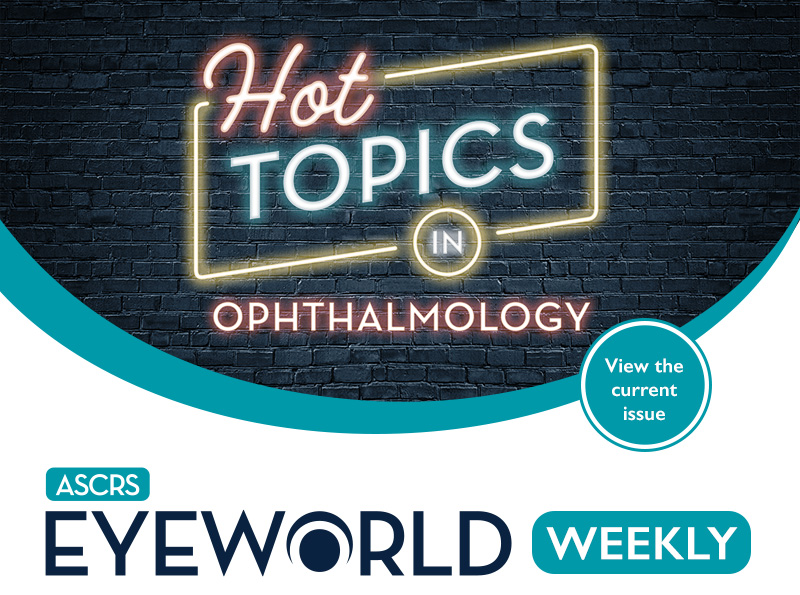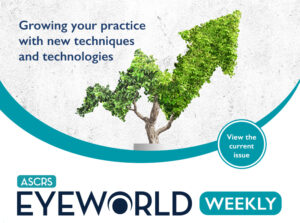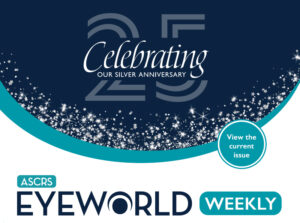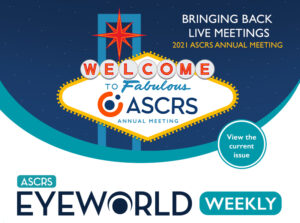
- Patient enrollment complete for sustained release AMD therapy trial
- First patient dosed with corneal endothelial cell substitute
- First patient dosed in RNAi therapy for wet and dry AMD
- Study: early signs of corneal graft rejection reversed with steroid nanoparticle
- Company announces anti-VEGF market tracker
- ASCRS news and events
March 31, 2023 • Volume 29, Number 13
Patient enrollment complete for sustained release AMD therapy trial
EyePoint Pharmaceuticals completed enrollment for its Phase 2 trial evaluating sustained release of EYP-1901 for treatment of wet AMD. According to the company’s press release, enrollment of 160 patients exceeded the original target of 144 patients. The participants were originally treated with standard of care anti-VEGF therapy then were randomized to receive one of two doses of EYP-1901 or aflibercept (control). EYP-1901 is delivered via intravitreal injection and is based on sustained release through the bioerodible Durasert insert with vorolanib, a tyrosine inhibitor, according to the company’s press release. The primary efficacy endpoint of the study is change in BCVA compared to control after 6 months. Secondary endpoints are central subfield thickness, number of eyes that remain free from supplemental anti-VEGF injections, number of aflibercept injections in each group, and safety.
First patient dosed with corneal endothelial cell substitute
Cellusion announced the first-in-human delivery of iPS (induced pluripotent stem) cell-derived corneal endothelial cell substitute (CLS001) in a patient with bullous keratopathy. The study was conducted at Keio University Hospital in Japan. According to the company’s press release, no adverse events have been observed at 3 months post-transplantation. In addition, visual acuity, central corneal thickness, and minimal corneal thickness have improved. The goal of CLS001 would be to reduce dependence on donor corneas, which are in short supply.
First patient dosed in RNAi therapy for wet and dry AMD
OliX Pharmaceuticals announced that the first patient has been dosed in its Phase 1 clinical trial evaluating an investigational RNAi therapy to treat wet and dry AMD. OLX10212, according to the company, targets inflammation pathways that can play a role in the development of this disease. The Phase 1 multicenter, single- and multi-dose dose-escalation study in the U.S. is enrolling up to 60 patients.
Study: early signs of corneal graft rejection reversed with steroid nanoparticle
Researchers from the Virginia Commonwealth University found that dexamethasone sodium phosphate encapsulated in a nanoparticle could help prevent corneal graft rejections while also avoiding IOP spikes and ocular toxicity issues. The research is published in Science Advances. According to the university’s press release, the nanoparticle delivery of this steroid reduces dosage of the drug with similar efficacy to the standard drop therapy. It also reduces compliance issues commonly associated with drop therapy. The research found that early signs of graft rejection were reversed in a rat model, and grafts were maintained for 6 months without rejection, according to the university.
Company announces anti-VEGF market tracker
Verana Health unveiled its Qdata Anti-VEGF Market Tracker, which is based on real-world data from the American Academy of Ophthalmology IRIS Registry. The tracker includes de-identified patients with retinal conditions and provides, according to the company’s press release, “granular market segmentation down to the brand level” that can be used to inform commercial planning, marketing, market uptake analysis, and more.
ASCRS news and events
- ASCRS Annual Meeting: Register for the ASCRS Annual Meeting, May 5–8, in San Diego, California, before the Tier 2 registration deadline on April 2. Check the ASCRS ASOA Real-Time Program for the latest program details.
- Eyecelerator: Registration is open for Eyecelerator @ ASCRS 2023. The innovation conference from ASCRS and the American Academy of Ophthalmology will be held on May 4 in San Diego, California. Join investors, industry leaders, and ophthalmologists at this showcase of companies, technology, and other exciting innovation topics in ophthalmology.
Research highlights
- A prospective, randomized, contralateral eye study comparing patient-reported quality of vision and visual symptoms after LASIK and SMILE was published in the Journal of Cataract & Refractive Surgery. Patients (n=40, 80 eyes) were randomized to receive wavefront-guided femtosecond LASIK in one eye and SMILE in their other. According to the paper, there was no difference in presence or severity of visual symptoms like double vision, glare, halos, or starbursts. Visual symptoms that were present preoperatively improved postoperatively. The authors reported that at month 12, 12 of 37 participants preferred vision in the eye that had LASIK compared to 7 of 37 who preferred SMILE. The preferred eye, the authors noted, was correlated with uncorrected distance visual acuity.
- A randomized clinical trial evaluated the adverse effects of a 3-week course of weekly oral azithromycin to those of a 6-week course of oral doxycycline for treatment of moderate to severe MGD. The authors reported that oral doxycycline and its known adverse effects could cause poor compliance, which led them to study a shorter course of treatment with azithromycin. The study included 137 eyes (68 receiving azithromycin and 69 receiving doxycycline) that completed 6- and 8-week follow-up visits. The mean difference in MGD scores between the groups at week 6 and week 8 were –0.33 and 0.13, respectively. The study reported an adjusted mean difference of OSDI scores between groups of –1.20 and –1.59 at weeks 6 and 8, respectively. Patients taking azithromycin reported fewer gastrointestinal adverse events (4.4% vs. 15.9%), according to the paper. The authors wrote that this data supports the “equivalency of effects of azithromycin compared to doxycycline for MGD score and OSDI score.” They stated that “reduced dosing and potentially fewer gastrointestinal [adverse effects] associated with azithromycin support its use as an alternative to doxycycline for at least 6 weeks.” The study is published in JAMA Ophthalmology.
Product news
- Haag-Streit launched its Eyestar 900 Anterior Chamber Suite.
This issue of EyeWorld Weekly was edited by Stacy Jablonski, Liz Hillman, and Ellen Stodola.
EyeWorld Weekly (ISSN 1089-0319), a digital publication of the American Society of Cataract and Refractive Surgery (ASCRS), is published every Friday, distributed by email, and posted live on Friday.
Medical Editors: Sumit “Sam” Garg, MD, Chief Medical Editor, Mitchell Weikert, MD, Cataract Editor, Karolinne Rocha, MD, PhD, Refractive Editor, Julie Schallhorn, MD, Cornea Editor, Manjool Shah, MD, Glaucoma Editor
For sponsorship opportunities or membership information, contact: ASCRS • 12587 Fair Lakes Circle • Suite 348 • Fairfax, VA 22033 • Phone: 703-591-2220 • Fax: 703-591-0614 • Email: ascrs@ascrs.org
Mention of products or services in EyeWorld Weekly does not constitute an endorsement by ASCRS.
Click here to view our Legal Notice.
Copyright 2023, EyeWorld News Service. All rights reserved.



